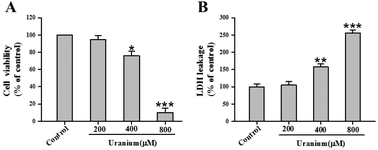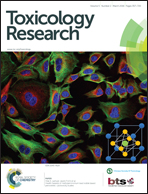Uranium-induced rat kidney cell cytotoxicity is mediated by decreased endogenous hydrogen sulfide (H2S) generation involved in reduced Nrf2 levels
Abstract
The mechanism of uranium-induced kidney cell cytotoxicity is not fully understood. Nrf2 is a transcription factor which can regulate gene expression of cystathionine β-synthase (CBS) and cystathionine γ-lyase (CSE) which are responsible for endogenous H2S formation. H2S is recognized as the gaseous mediator that exerts antioxidative and cytoprotective effects. Here, we assessed the in vitro effects of uranyl acetate on Nrf2 gene expression and endogenous H2S production in a stable rat kidney cell line (NRK-52E). The results imply that uranium treatment decreased cell viability and increased LDH release, indicating uranium-induced cytotoxicity. Uranium intoxication increased intracellular ROS and MDA contents, depleted GSH levels, and impaired SOD and CAT activities, which resulted in oxidative stress injuries. Uranium intoxication reduced CBS and CSE gene expression and endogenous H2S production. Uranium contamination decreased Nrf2 protein expression and nuclear translocation. RNA silencing of Nrf2 gene expression in kidney cells which had not been treated by uranium decreased CBS and CSE gene expression and endogenous H2S generation, which mirrored the effects of uranium exposure. In contrast, treating uranium-exposed kidney cells with Nrf2 activator (sulforaphane) preserved the protein levels of Nrf2, CBS and CSE, and endogenous H2S formation. Administration of NaHS (an H2S donor) to uranium-intoxicated kidney cells reduced cell damage and alleviated oxidative stress. These data imply that uranium-induced kidney cell cytotoxicity is mediated by decreased endogenous H2S production due to the down-regulation of CBS and CSE gene expression and reduced Nrf2 levels. Supplementary H2S generation and/or Nrf2 activation can mitigate the adverse effects of uranium on kidney cells.


 Please wait while we load your content...
Please wait while we load your content...